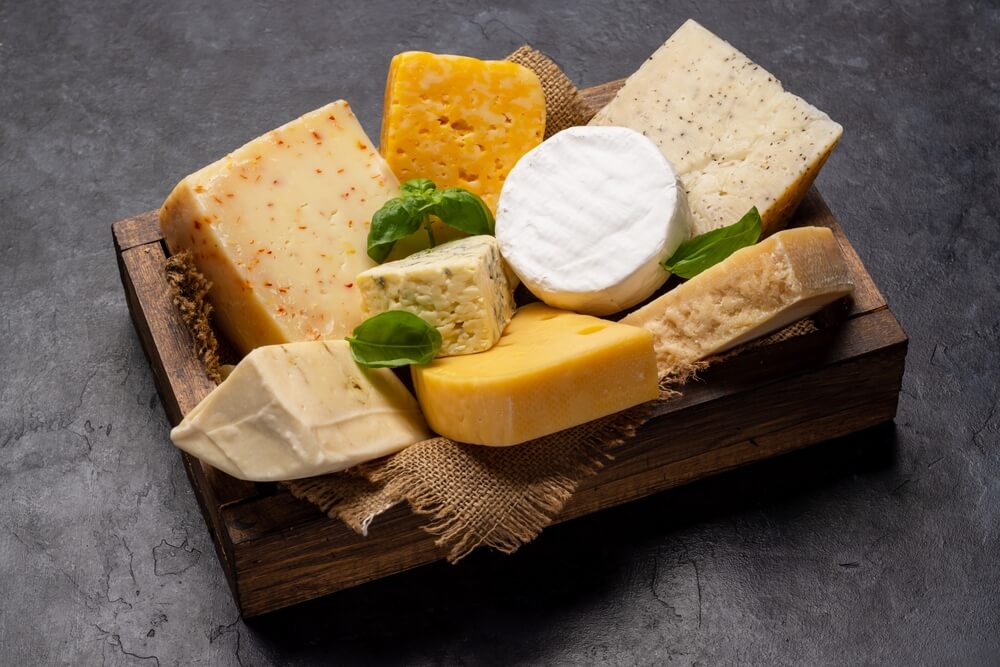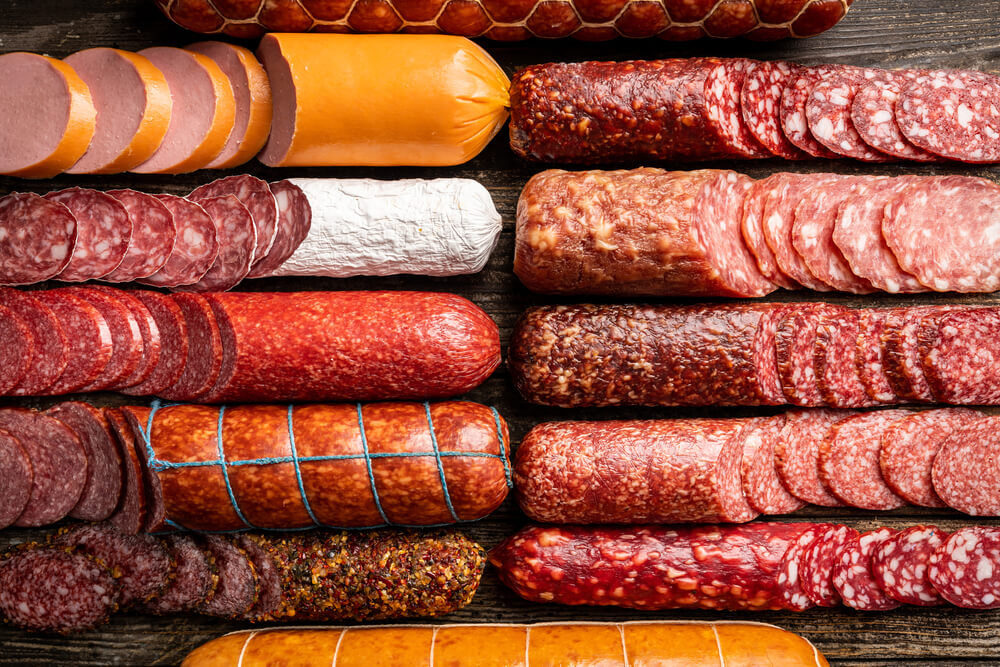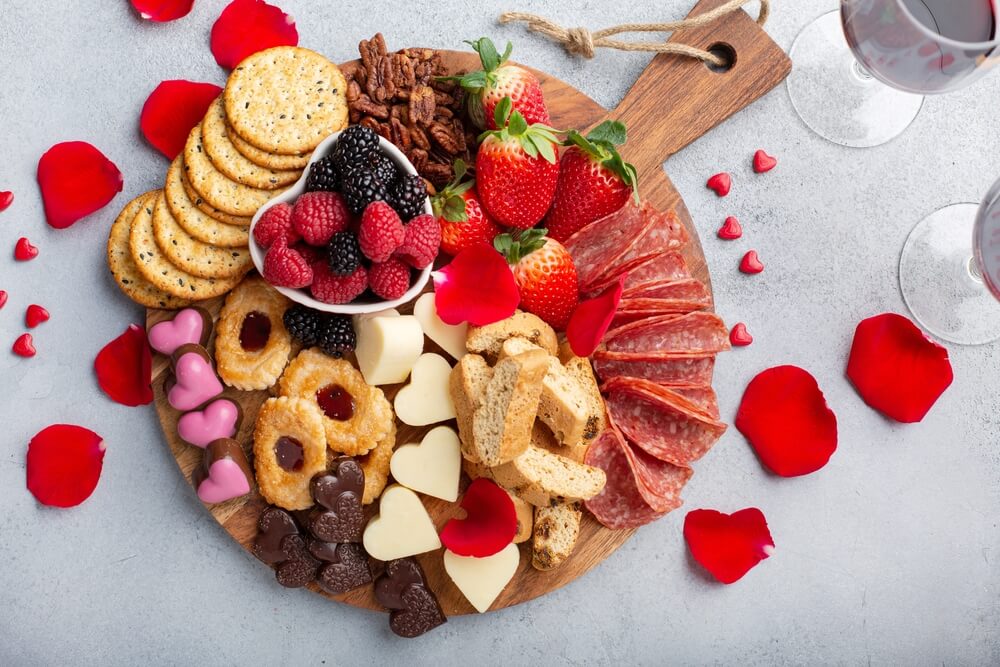
Charcuterie boards are all of the rage. Why? They’re easy to make, easy to enjoy, and you can customize them based on the event you’re making them for. We’re going to break down the basics of putting together a basic charcuterie spread, plus how to arrange a holiday charcuterie board for every season!
Making a Charcuterie Board: The Basics
There are 3 basic items that make up the base of your charcuterie board: cheese, meat, and crackers.

Cheeses For a Charcuterie Board
Wisconsin Cheese suggests that the best charcuterie boards have 4-6 different cheese varieties with a range of textures and flavors. We’ll explain the 4 classifications of textures and provide some examples for each.
Hard cheese — requires the longest aging process compared to other types of cheeses. The slow ripening process, which can last longer than 9 months, gives hard cheese a low water content, resulting in a texture that’s dry and crumbly, and a taste that’s rich and complex.
Some types of hard cheeses for a charcuterie board could include
- Aged Gouda
- Parmesan
- Asiago
- Gruyère
Firm cheese — also referred to as “semi-hard” cheese, takes less time than hard cheese to mature. The aging process of firm cheese is anywhere from 1 to 6 months, resulting in a cheese that’s less complex and milder in taste.
In terms of texture, firm cheese is denser than hard cheese which helps hold its shape better when being sliced.
Some types of firm cheeses for a charcuterie board could include
- Cheddar
- Gouda
- Havarti
- Manchego
Semi-soft cheese — requires the shortest aging process. Because of this, they have a higher moisture content than firm and hard cheese varieties, giving them a smooth, buttery texture. The taste of semi-soft cheese relies heavily on how it was aged; it can taste rich, salty, sharp, or nutty.
Some types of semi-soft cheeses for a charcuterie board could include
- Monterey Jack
- Brie
- Fontal
- Muenster
Soft cheese — sometimes called “fresh” cheese, is not aged. Therefore, soft cheeses have a high moisture content. Its soft texture makes it easy for crumbling to top a salad or dish, or spreading on a cracker or bread. Like semi-soft cheeses, the flavor of soft cheese can be anywhere from mild to complex.
Some types of soft cheeses for a charcuterie board could include
- Mozzarella
- Goat
- Boursin
- Burrata
Meats For a Charcuterie Board
While cheese is the star of the show, your charcuterie board wouldn’t be the same without some meats. You should consider having at least 3-4 different meats to complement the flavors and textures of the cheese.
Some meats that you can choose for your spread could include
- Prosciutto: a thinly-sliced, dry-cured ham that tastes both salty and sweet.
- Soppressata: a coarsely-ground, slightly-chewy Italian salami that tastes similar to pepperoni.
- Chorizo: a Spanish pork sausage that’s cured or smoked, giving it a mild, spicy, and smokey flavor.
- Pepperoni: beef or pork that’s dried, cured, and seasoned to have a flavor that’s salty, spicy, and tangy. (Technically, this is a type of salami.)
- Salami: any type of cured meat made from pork, beef, veal, etc. There are hundreds of different types, any of which could be added to your charcuterie board.
Crackers For a Charcuterie Board
The final item that makes up the base of your charcuterie board is crackers. This adds some crunch to balance out the softness of the meats and cheeses.
While we use the word “crackers,” the term in this context can include other crunchy, toasted, bread-based items. Aim to have 2-3 variations on your board.
Some crackers that you can choose for a charcuterie board include
-
- Crackers: any crackers will do — Ritz, Toasteds, Carr’s, really whatever you like!
- Arisan/Herb Crackers: the crunch of normal crackers with a more complex, herbal flavor.
- Crostini: a crispy, Italian appetizer that’s made of toasted or grilled bread.
- Classic Italian Breadsticks: long, thin breadsticks with a crispy and fulfilling bite.
Charcuterie Board Fillers or Accompaniments
After the base of your charcuterie board is complete with cheese, meat, and crackers, the final step is to liven up the spread with some accompaniments. Here’s where you can start to get creative and add specific items to craft the perfect holiday charcuterie board.
Before we jump into specifics of how to make holiday charcuterie boards, we’ll outline some of the fruits, jams, or other items that you can use to fill in the empty space on your board.
Fruits
- Blueberries, strawberries, raspberries, or blackberries
- Sliced apples, pears, or tangerines
- Pomegranates, grapes, or figs
- Any dried fruit
Vegetables
- Cucumbers, carrots, or celery
- Cherry tomatoes
- Sliced bell peppers or mini sweet peppers
Nuts and Seeds
- Almonds
- Walnuts
- Pistachios
- Sunflower seeds
Spreads
- Fresh jelly or jam
- Fig
- Spicy mustard
- Honey
Other Items
- Pickles
- Olives
- Pretzels
- Chocolate
Hopefully, our list gives you an idea of how to add some depth (in both flavor and substance) to your charcuterie board. Consider choosing at least 2-3 different accompaniments and 1-2 different spreads to complete your board.
Build a Holiday Charcuterie Board For Every Event
Charcuterie boards are a great addition to any party or event. Try making a holiday charcuterie board for your next celebration. We’ve listed out some ways that you can customize your board for every season!
Valentine’s Day Charcuterie Board
Chocolate, hearts, red, pink — these are all emblems that come to mind when we think of Valentine’s day. Your Valentine’s Day charcuterie board should be designed to include all of those same characteristics.
Reach for red, pink, and/or white items when possible to fill in the space on your board. Whether you’re making it for your Galentine’s party or a night in with your significant other, a charcuterie board filled with sweets is a must.
Here’s what you’ll need:
- 3-4 cheeses: brie, cheddar, colby jack, and/or manchego.
- 2-3 meats: pepperoni, prosciutto, and/or salami.
- 4-5 fillers: strawberries, raspberries, chocolate-covered strawberries, chocolate-covered pretzels, and/or heart-shaped candy (candy hearts, chocolate, etc.)
- 1-2 crackers: (heart-shaped) water crackers and/or club crackers
- 1-2 spreads: fig and/or melted chocolate
When it comes to presentation, think of everything that is heart-shaped. If you can, try to buy heart-shaped items or use a heart-shaped cookie cutter to slice your cheese and meats into hearts. Use the champagne glass or shot glass trick to shape your sliced meat into a flower.
Christmas Charcuterie Boards
To craft your perfect Christmas charcuterie board, you’ll need an assortment of items. The obvious advice is to choose items that are red and green, but also consider swapping some of your favorite fruits that aren’t in season with some dry fruit like raisins, almonds, or walnuts.
We suggest using:
- 5-6 cheeses: mozzarella, colby jack, cheddar, goat, havarti, and/or muenster
- 4-5 meats: pepperoni, chorizo, salami, prosciutto, and/or sweet bologna
- 5-6 fillers: grapes, cucumber, red/green peppers, apple, walnuts, and/or olives
- 2-3 crackers: crostini, rosemary crackers, and/or water crackers
- 1-2 spreads: honey and/or jelly or jam
You can get creative with the presentation of your Christmas charcuterie board. You could arrange your items in the shape of a tree, wreath, or candy cane. Visualize the general shape of the item and start filling the space with layers of alternating foods.
Consider adding some fresh herbs or greenery throughout your charcuterie board to add some color. Rosemary sprigs or eucalyptus leaves are great options to add some winter greens to your spread.
Mother’s Day Charcuterie Board
Mother’s Day happens in the Springtime, so if you’re making a charcuterie board to celebrate keep it fresh, colorful, and sweet. Consider including lots of fresh fruit along with some sweet treats that you know mom loves.
We suggest using
-
- 3-4 cheeses: brie, muenster, goat, and/or cheddar
- 1-2 meats: salami and/or soppressata
- 3-4 fillers: fresh berries, chocolate-covered almonds, oranges, and/or wrapped chocolates
- 1-2 crackers: mini croissants and/or water crackers
- 1-2 spreads: honey and/or fruit jam
In the spirit of Spring, add some flowers from your garden to arrange throughout your board. If you don’t have fresh flowers, make your own out of salami using the glass method from before!
4th of July Charcuterie Board
Similar to your mother’s day spread, your 4th of July charcuterie board should be fresh. Choose your fruits and veggies strategically. If you can, purchase items that fit the color theme: red, white, and blue.
We recommend using:
-
- 3-4 cheeses: brie, cheddar, guèye, and/or mozzarella
- 2-3 meats: pepperoni, chorizo, and/or salami
- 4-5 fillers: red peppers, cauliflower, watermelon, strawberries, and/or blueberries
- 1-2 crackers: water crackers and/or club crackers
- 1-2 spreads: ranch and/or strawberry or blueberry jam
When it comes to presentation, there are a couple of ways you can arrange your board. If you went with all red, white, and blue items, try organizing your charcuterie board like an American flag: blue foods in the corner with alternating rows of red and white snacks.
If that sounds too tedious, arrange your board as usual and use a star cookie cutter to cut some of the cheese, meat, or fruit into stars to arrange sporadically across your spread. For an added touch, grab some of these small flag toothpicks to place around the board.
Remember, the great part about putting together a charcuterie board is that you can customize it to fit any event or palette.









